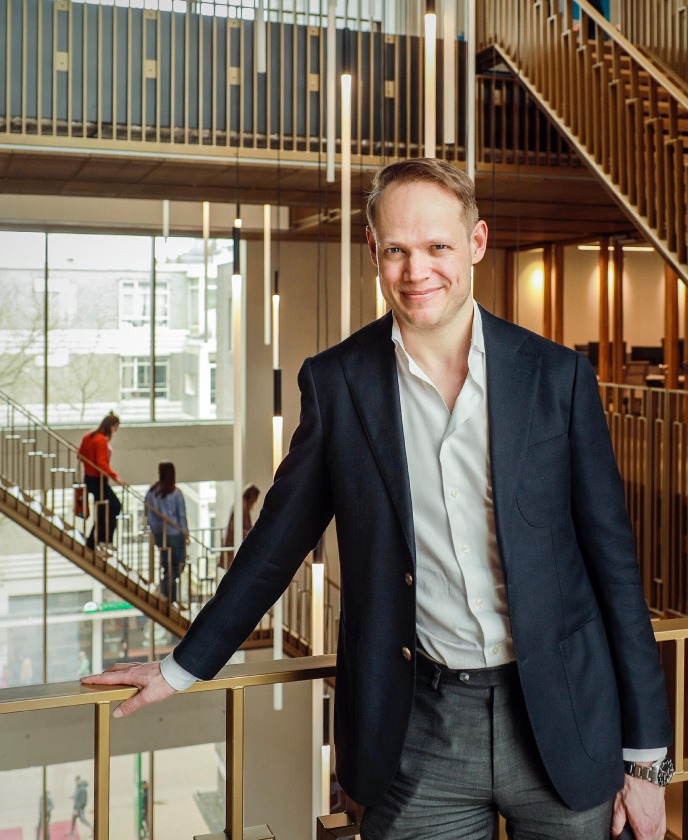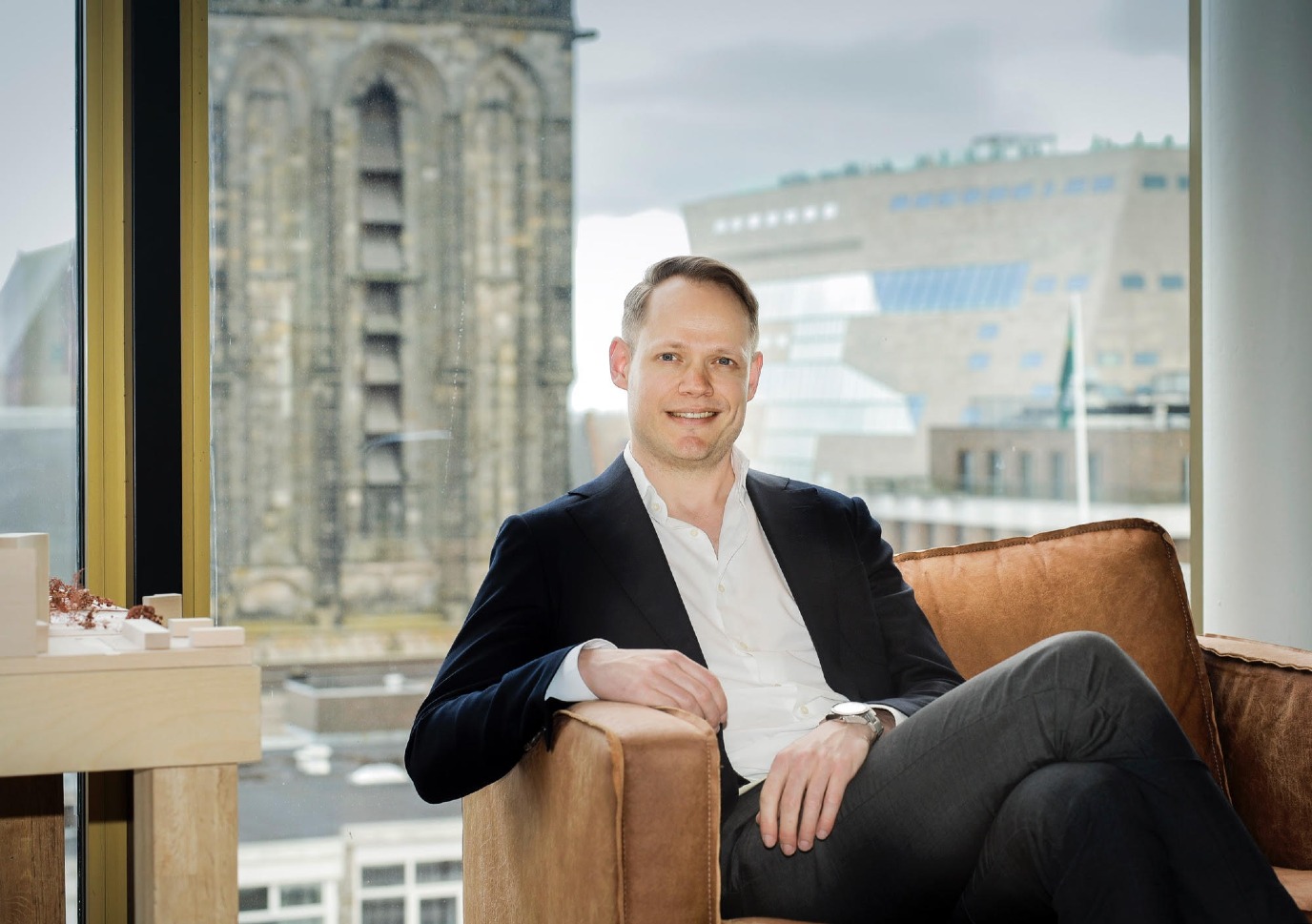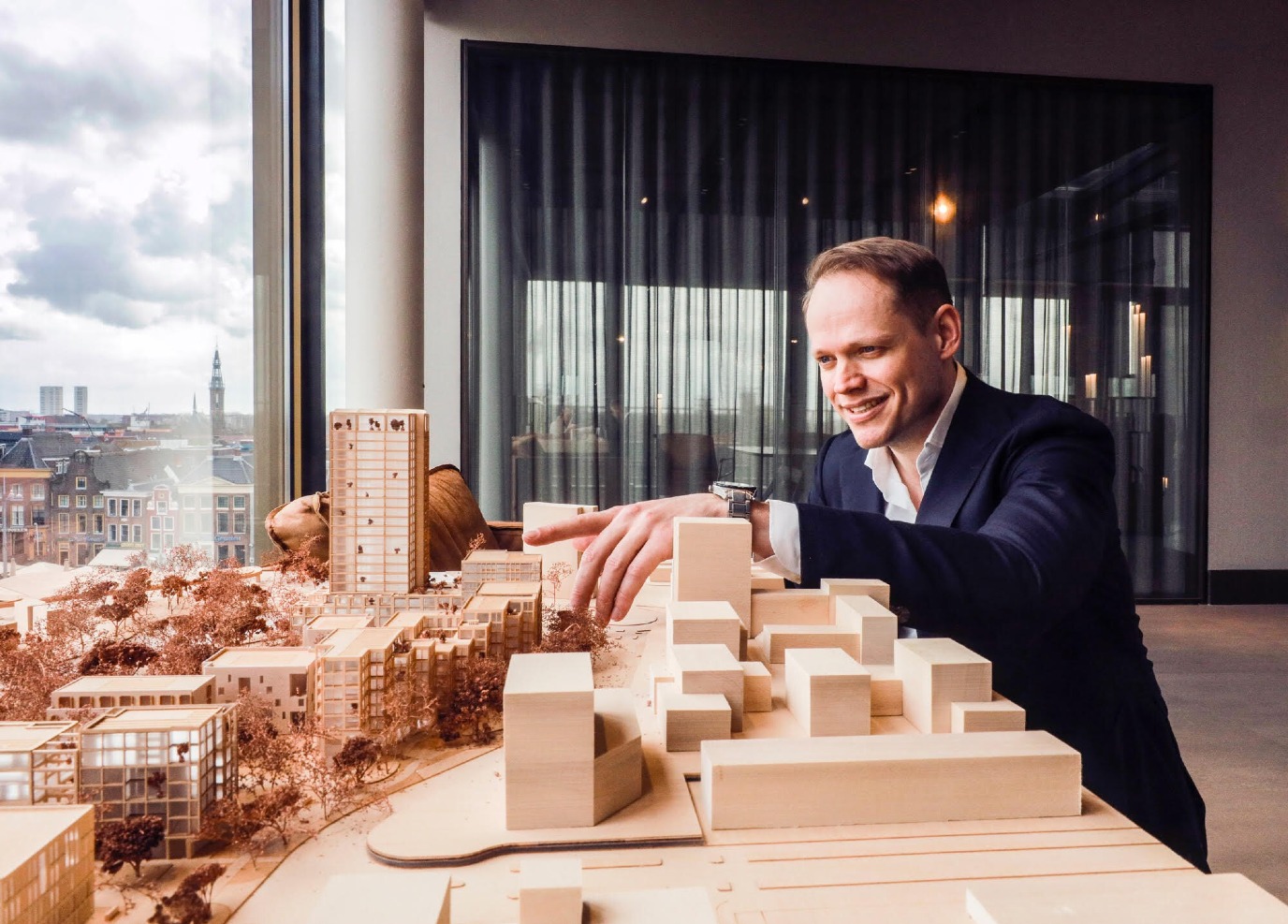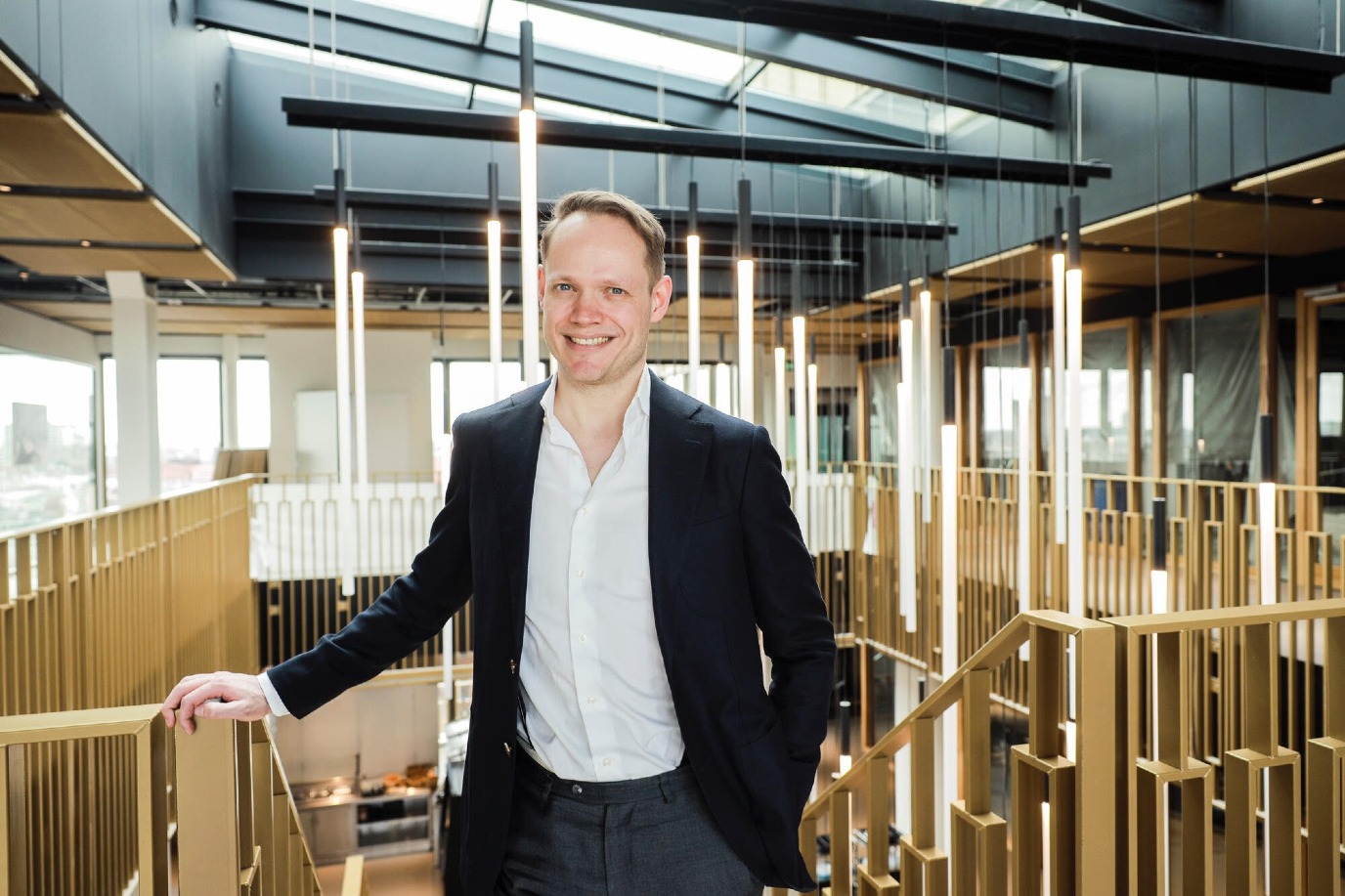Kloof stad - regio groeit. 'Sinds de financiële crisis zien vastgoedinvesteerders de regio als risico,' vertelt onderzoeker dr. Michiel Daams.

Investeringen in vastgoed blijken een belangrijke verklaring voor de kloof tussen grote steden en de regio, stelt Michiel Daams, universitair docent Economische Geografie van de Vastgoedmarkt. Hij deed onderzoek naar investeringen in het Verenigd Koninkrijk en de Verenigde Staten. Volgens Daams speelt in Nederland mogelijk hetzelfde. ‘Investeerders hebben hun geld sinds de financiële crisis onder het matras van de grote steden gestopt, terwijl de regio achterblijft.’
Tekst: Jelle Posthuma / Foto's: Henk Veenstra
dr. Michiel Daams is thema directeur van het 'Sustainable Landscapes and Regions' thema van de Rudolf Agricola School for Sustainable Development.
De vastgoedmarkt, het vakgebied van Daams, ligt door de huidige wooncrisis al jaren onder een vergrootglas. Woningzoekenden krijgen op de huidige markt te maken met stijgende huizenprijzen en hoge huren. ‘Enerzijds kan je heel basaal zeggen dat het goed gaat met Nederland: er willen veel mensen wonen, want er is een hoge vraag’, stelt Daams. ‘Tegelijkertijd staan we voor een gigantische uitdaging. Een woningaanbod dat niet op orde is, raakt aan de fundamenten van ons bestaan. Iedereen wil een dak boven zijn hoofd.’
Daams kijkt in zijn onderzoek vooral naar de economische geografie van de commerciële vastgoed- en grondmarkten. ‘Het gaat over de plekken waar we wonen, werken en recreëren. Hoe organiseren we onze ruimte toekomstbestendig? Die vraag staat centraal. Vastgoed is een ontzettend breed vakgebied dat diverse aspecten van investeren tot beleid met elkaar verbindt. Het omvat tot wel tachtig procent van de waarde van al het materiële bezit in ontwikkelde landen. Vastgoedprojecten zijn kortom bepalend voor ons dagelijks leven. Dat maakt het een fascinerend onderzoeksgebied.’

De waarde van natuur
Als student en later promovendus richtte Daams zich op de natuur en het gebruik van grond. ‘De natuur is grondgebonden, maar er zit ook een menselijke kant aan. In mijn onderzoek stelde ik de vraag hoe mensen natuur waarderen. De vastgoedmarkt bleek daarvoor een goede indicator. Aan de hand van huizenprijzen kunnen we zien hoe mensen natuur waarderen. Door deze relatie aan te tonen, kunnen we ook publieke investeringen in de natuur beter legitimeren. Vanuit deze vraag kwam ik terecht in de vastgoedanalyse.’
Volgens Daams waren er tot dan toe geen goede instrumenten om de relatie tussen waardevolle natuur en huizenprijzen te meten. Tijdens zijn promotieonderzoek ging Daams aan de slag met de vraag: hoe krijg je grip op de waarde van natuur? ‘Er waren wel modellen, die bijvoorbeeld de nabijheid van een park of bos meenamen in de woningprijs. Een park binnen vijfhonderd meter was dan een plus voor de prijs. Maar deze modellen hadden geen idee wat een aantrekkelijk park is. Het ene park is het andere niet: een willekeurig parkje is wat anders dan het Noorderplantsoen.’
Er was kortom geen goed model voor de analyse. Aan de hand van de Greenmapper survey van zijn copromotor, Frans Sijtsma, wist Daams welke natuurgebieden Nederlanders het hoogst waarderen. ‘Zo konden we de menselijke kant in onze vastgoedmodellen verwerken. Het ‘verrassende’ was dat het effect van natuur op de huizenprijzen niet bij vijfhonderd meter stopt. Voor de meest aantrekkelijke natuurplekken geldt het effect op de huizenprijzen tot wel zeven kilometer. Dat raakt veel meer woningen dan eerdere studies lieten zien. Met deze analyse is het voor mij begonnen.’

Financiële crisis
Onlangs publiceerde Daams de eerste resultaten van een grootschalig onderzoek naar het verschil tussen vastgoedinvesteringen in grote steden en de regio. Samen met zijn collega-onderzoekers bestudeerde hij grote investeringen in commerciële panden in het Verenigd Koninkrijk en de Verenigde Staten. ‘Deze investeringen zijn langdurig en grondgebonden. Ze signaleren hoe de bredere financiële markt naar regio’s kijkt. We zien aan alle kanten de kloof tussen steden en regio’s groeien, maar hoe werkt dit aan de kant van de commerciële investeerders? Die vraag stelden we onszelf.’
Tijdens de financiële crisis, in 2008, vluchtten in het Verenigd Koninkrijk investeerders massaal met hun geld naar Londen, vertelt Daams. Voor de Verenigde Staten gold hetzelfde voor de grote Amerikaanse kuststeden. ‘Daar zit je relatief veilig als de economie in zou storten, was de perceptie van investeerders. Tijdens het begin van de crisis hadden handelskantoren in Londen het gigantisch druk.’
Risico’s
Na de crisis herstelde de economie gestaag, maar de investeerders zijn in de grote en al rijke steden gebleven, blijkt uit het onderzoek van Daams. ‘Dit duurt nu al vijftien jaar. Investeerders hebben hun geld onder het matras van de grote steden gestopt, terwijl de regio achterblijft.’ Voor investeerders draait het om risico’s, legt hij uit. ‘Sinds de financiële crisis zijn er grote verschillen ontstaan tussen de risicoanalyse voor grote steden en de regio. In het Verenigd Koninkrijk worden perifere gebieden door investeerders zelfs gezien alsof het zogeheten ‘junk bonds’ zijn, oftewel zeer riskante obligaties.’
Deze ongelijke inschatting zorgt voor grote verschillen binnen een land, weet Daams. ‘De kloof in risico’s voor een investering in een regio in het Verenigd Koninkrijk wordt door investeerders, ten opzichte van Londen, hetzelfde ingeschaald als de kloof tussen nationale investeringen in het Verenigd Koninkrijk versus Roemenië of Chili. In de VS zien we hetzelfde voor de grote kuststeden en de rest van het land. Voor de crisis waren er ook verschillen tussen grote steden en de regio, maar de risico’s werden veel gelijker ingeschat. De financiële crisis zorgde echt voor een systeemverandering.’
Volgens Daams duidt dit op hoge kosten voor de regio om private investeringen aan te trekken, die nodig zijn voor groei en bedrijvigheid. ‘Het beeld dat we schetsen in ons onderzoek wordt aan alle kanten erkend en herkend door mensen uit de praktijk, van beleidsmakers tot investeringsbanken. Hoewel we in Nederland nog geen onderzoek hebben gedaan, zie je hier mogelijk hetzelfde gebeuren. Kijk maar naar steden als Amsterdam en relatief minder sterke regio’s.'

Dezelfde taal spreken
Aan beleidsmakers de taak om het private geld weer naar de regio te halen, vervolgt Daams. ‘Ze zullen investeerders moeten verleiden. Om dat te bereiken, is dezelfde taal nodig. Ons onderzoek speelt daarin een rol: door te onderbouwen en becijferen hoe investeerders over regio’s denken, kun je gezamenlijk over maatregelen nadenken.’ Hetzelfde geldt voor de woningmarkt, weet de universitair docent. ‘Er wordt soms met scheve ogen gekeken naar vastgoedinvesteerders die naar rendement zoeken, maar het is ook gewoon marktwerking. Het grote geld is uiteindelijk nodig om op grote schaal te bouwen. Aan onderzoekers de taak om kennis te leveren, zodat beleidsmakers en investeerders elkaar beter weten te vinden.’
Daams benadrukt eveneens het belang om experts bij elkaar te brengen, om op zoek te gaan naar praktische oplossingen. ‘Ik heb zelf geen sluitend antwoord op de wooncrisis. Er zijn ontzettend veel facetten die een rol spelen op de woningmarkt. Daarvoor zullen we disciplines samen moeten brengen. Het landschap van experts is op dit moment nog erg versnipperd. Om tot collectieve analytische capaciteit te komen, is het zaak om kennis te verbinden en te bundelen. Hetzelfde geldt voor het verbinden van de markt en het beleid.’
Rudolf Agricola School
Deze verbindende rol speelt Daams eveneens bij de Rudolf Agricola School for Sustainable Development, één van de vier Schools of Science & Society van de Rijksuniversiteit Groningen. Daams is directeur van het thema Sustainable Landscapes and Regions. ‘Ik probeer met ons team onze fellows, de ruim tweehonderdvijftig onderzoekers verbonden met de vier onderzoeksthema’s van de Rudolf Agricola School, met elkaar en met externe partners te verbinden, voor krachtige interdisciplinaire wetenschap en impact.’
Met wetenschappelijke ‘impactproducten’ verbindt de School bijvoorbeeld beleid, onderzoek en burgers. Daams noemt onder meer een digitaal platform dat inzichten van landschapsexperts bijeenbrengt. ‘Dit leidt tot een vakoverstijgend begrip van grote uitdagingen en mogelijke oplossingen voor betere biodiversiteit in veeteeltgebieden. Ook worden strategische banden met partneruniversiteiten versterkt met interdisciplinaire PhD programma’s. Altijd om de fellows en hun ínterdisciplinaire onderzoeksgroepen bij onze School in stelling te brengen. Het is een ontzettend dankbare rol om daaraan bij te dragen.’
Meer informatie
Publicatie over Daams' onderzoek:
Capital shocks and the great urban divide, in: Journal of Economic Geography, Volume 24, Issue 1, January 2024,

